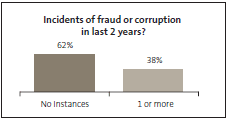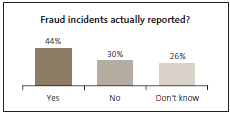Part 3: Incidents of fraud in government departments
Despite our generally "clean" image, fraud is a fact of business life in New Zealand: 38% of government departments were aware of at least one incident of fraud or corruption in their entity within the last two years.
 Those who knew of an incident in the last two years were asked for details of the most recent incident. Nearly 85% of the incidents in government departments were committed by one internal person acting alone, typically at an operational or administration/support staff level.
Those who knew of an incident in the last two years were asked for details of the most recent incident. Nearly 85% of the incidents in government departments were committed by one internal person acting alone, typically at an operational or administration/support staff level.
The value of the most recent fraud noted by respondents in government departments was mostly low, with 38% of frauds being for amounts of less than $1,000. There was no monetary loss for 7% of fraud incidents, and 22% were between $1,000 and $10,000. One fifth of the respondents who answered this question did not know how much money was lost.
These trends in low dollar values were common to all sectors in the survey. It is not always possible to accurately establish how much money has been lost in a fraud because sometimes the records and the investigation are incomplete.
The most frequent types of fraud within government departments were reported to be:
- fraudulent expense claims (22%);
- fraudulent misuse of credit cards (17%); and
- theft of property, plant, and equipment, or inventory (11% combined).
Government departments also experienced theft of cash (9%), payroll fraud (such as falsifying timesheets or annual leave) (9%), and conflicts of interest fraud (such as making or receiving payments, or receiving undeclared gifts or services, to influence a decision or give preferential treatment) (7%).
Respondents said that the fraud occurred because internal controls, policies, or procedures were not followed (39%), and that the perpetrator did not think they would get caught (38%).
Internal control systems were government departments' most successful mechanism for detecting fraud, with 39% of the frauds detected in this way. Internal tip-offs (other than through a formal whistle-blower system) identified 19% of fraud incidents.
Strong internal controls and an anti-fraud culture have proven most successful in preventing and later detecting fraud, should it occur.
Respondents said that none of the fraud incidents were detected by the external auditor. This is not surprising, because detecting fraud is not the purpose nor the focus of an external audit.
 Although 70% of government department respondents felt confident that incidents of fraud would be reported to the appropriate law enforcement agency, this was the lowest percentage for any of the central government entity types and for all of the public sector.
Although 70% of government department respondents felt confident that incidents of fraud would be reported to the appropriate law enforcement agency, this was the lowest percentage for any of the central government entity types and for all of the public sector.
When fraud had occurred, respondents said that 44% of these incidents were actually reported to the appropriate law enforcement agency. This percentage was in keeping with that of other central government entities and all of the public sector.
 Any decision made not to report or respond to fraud can erode staff confidence in the senior management team. It can create a perception that managers are not committed enough to preventing fraud and discourage staff from reporting their concerns. Not reporting fraudulent behaviour also increases the risk that an employee suspected of committing fraud could move to another public entity and continue their dishonest behaviour.
Any decision made not to report or respond to fraud can erode staff confidence in the senior management team. It can create a perception that managers are not committed enough to preventing fraud and discourage staff from reporting their concerns. Not reporting fraudulent behaviour also increases the risk that an employee suspected of committing fraud could move to another public entity and continue their dishonest behaviour.
Questions 32 to 40 in Appendix 1 set out the survey response data about incidents of fraud.
page top